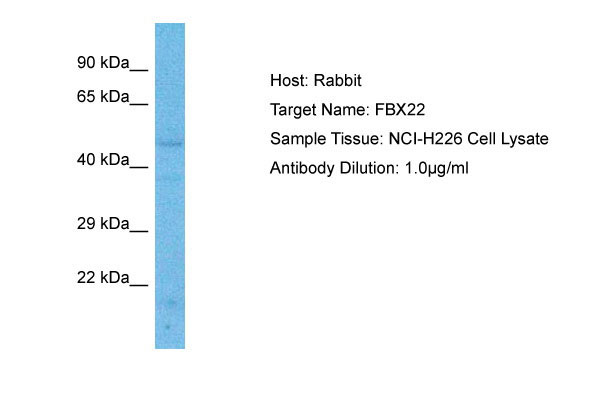FBX22 Antibody - middle region
Rabbit Polyclonal Antibody
- 产品详情
- 实验流程
- 背景知识
Application
| WB |
|---|---|
| Primary Accession | Q8NEZ5 |
| Reactivity | Human |
| Host | Rabbit |
| Clonality | Polyclonal |
| Calculated MW | 44508 Da |
| Gene ID | 26263 |
|---|---|
| Alias Symbol | FBXO22, FBX22, |
| Other Names | F-box only protein 22, F-box protein FBX22p44, FBXO22, FBX22 |
| Format | Liquid. Purified antibody supplied in 1x PBS buffer with 0.09% (w/v) sodium azide and 2% sucrose. |
| Reconstitution & Storage | Add 50 &mu, l of distilled water. Final Anti-FBX22 antibody concentration is 1 mg/ml in PBS buffer with 2% sucrose. For longer periods of storage, store at -20°C. Avoid repeat freeze-thaw cycles. |
| Precautions | FBX22 Antibody - middle region is for research use only and not for use in diagnostic or therapeutic procedures. |
| Name | FBXO22 |
|---|---|
| Synonyms | FBX22 |
| Function | Substrate-recognition component of the SCF (SKP1-CUL1-F-box protein)-type E3 ubiquitin ligase complex that is implicated in the control of various cellular processes such as cell cycle control, transcriptional regulation, DNA damage repair, and apoptosis. Promotes the proteasome-dependent degradation of key sarcomeric proteins, such as alpha-actinin (ACTN2) and filamin-C (FLNC), essential for maintenance of normal contractile function. Acts as a key regulator of histone methylation marks namely H3K9 and H3K36 methylation through the regulation of histone demethylase KDM4A protein levels (PubMed:21768309). In complex with KDM4A, also regulates the abundance of TP53 by targeting methylated TP53 for degradation at the late senescent stage (PubMed:26868148). Under oxidative stress, promotes the ubiquitination and degradation of BACH1. Mechanistically, reactive oxygen species (ROS) covalently modify cysteine residues on the bZIP domain of BACH1, leading to its release from chromatin and making it accessible to FBXO22 (PubMed:39504958). Upon amino acid depletion, mediates 'Lys-27'-linked ubiquitination of MTOR and thereby inhibits substrate recruitment to mTORC1 (PubMed:37979583). Also inhibits SARS- CoV-2 replication by inducing NSP5 degradation (PubMed:39223933). |
| Cellular Location | Cytoplasm. Nucleus. Cytoplasm, myofibril, sarcomere, Z line. Note=Amino acid depletion lead to a time-dependent increase of FBXO22 in the cytoplasm. |
| Tissue Location | Predominantly expressed in liver, also enriched in cardiac muscle. |
For Research Use Only. Not For Use In Diagnostic Procedures.
Provided below are standard protocols that you may find useful for product applications.
BACKGROUND
Substrate-recognition component of the SCF (SKP1-CUL1-F- box protein)-type E3 ubiquitin ligase complex. Promotes the proteasome-dependent degradation of key sarcomeric proteins, such as alpha-actinin (ACTN2) and filamin-C (FLNC), essential for maintenance of normal contractile function.
REFERENCES
Tan P.,et al.Submitted (JUL-2000) to the EMBL/GenBank/DDBJ databases.
Ota T.,et al.Nat. Genet. 36:40-45(2004).
Zody M.C.,et al.Nature 440:671-675(2006).
Cenciarelli C.,et al.Curr. Biol. 9:1177-1179(1999).
Gauci S.,et al.Anal. Chem. 81:4493-4501(2009).
终于等到您。ABCEPTA(百远生物)抗体产品。
点击下方“我要评价 ”按钮提交您的反馈信息,您的反馈和评价是我们最宝贵的财富之一,
我们将在1-3个工作日内处理您的反馈信息。
如有疑问,联系:0512-88856768 tech-china@abcepta.com.























 癌症的基本特征包括细胞增殖、血管生成、迁移、凋亡逃避机制和细胞永生等。找到癌症发生过程中这些通路的关键标记物和对应的抗体用于检测至关重要。
癌症的基本特征包括细胞增殖、血管生成、迁移、凋亡逃避机制和细胞永生等。找到癌症发生过程中这些通路的关键标记物和对应的抗体用于检测至关重要。 为您推荐一个泛素化位点预测神器——泛素化分析工具,可以为您的蛋白的泛素化位点作出预测和评分。
为您推荐一个泛素化位点预测神器——泛素化分析工具,可以为您的蛋白的泛素化位点作出预测和评分。 细胞自噬受体图形绘图工具为你的蛋白的细胞受体结合位点作出预测和评分,识别结合到自噬通路中的蛋白是非常重要的,便于让我们理解自噬在正常生理、病理过程中的作用,如发育、细胞分化、神经退化性疾病、压力条件下、感染和癌症。
细胞自噬受体图形绘图工具为你的蛋白的细胞受体结合位点作出预测和评分,识别结合到自噬通路中的蛋白是非常重要的,便于让我们理解自噬在正常生理、病理过程中的作用,如发育、细胞分化、神经退化性疾病、压力条件下、感染和癌症。






